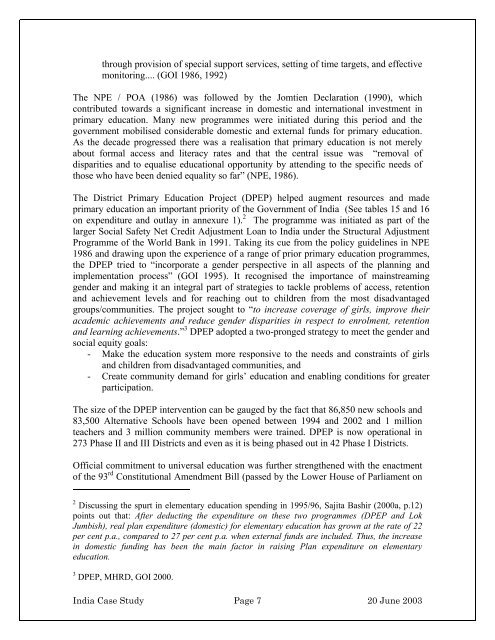Where are we today with respect to girls' education
Where are we today with respect to girls' education
Where are we today with respect to girls' education
- No tags were found...
You also want an ePaper? Increase the reach of your titles
YUMPU automatically turns print PDFs into web optimized ePapers that Google loves.
through provision of special support services, setting of time targets, and effectivemoni<strong>to</strong>ring.... (GOI 1986, 1992)The NPE / POA (1986) was follo<strong>we</strong>d by the Jomtien Declaration (1990), whichcontributed <strong>to</strong>wards a significant increase in domestic and international investment inprimary <strong>education</strong>. Many new programmes <strong>we</strong>re initiated during this period and thegovernment mobilised considerable domestic and external funds for primary <strong>education</strong>.As the decade progressed there was a realisation that primary <strong>education</strong> is not merelyabout formal access and literacy rates and that the central issue was “removal ofdisparities and <strong>to</strong> equalise <strong>education</strong>al opportunity by attending <strong>to</strong> the specific needs ofthose who have been denied equality so far” (NPE, 1986).The District Primary Education Project (DPEP) helped augment resources and madeprimary <strong>education</strong> an important priority of the Government of India (See tables 15 and 16on expenditure and outlay in annexure 1). 2 The programme was initiated as part of thelarger Social Safety Net Credit Adjustment Loan <strong>to</strong> India under the Structural AdjustmentProgramme of the World Bank in 1991. Taking its cue from the policy guidelines in NPE1986 and drawing upon the experience of a range of prior primary <strong>education</strong> programmes,the DPEP tried <strong>to</strong> “incorporate a gender perspective in all aspects of the planning andimplementation process” (GOI 1995). It recognised the importance of mainstreaminggender and making it an integral part of strategies <strong>to</strong> tackle problems of access, retentionand achievement levels and for reaching out <strong>to</strong> children from the most disadvantagedgroups/communities. The project sought <strong>to</strong> “<strong>to</strong> increase coverage of girls, improve theiracademic achievements and reduce gender disparities in <strong>respect</strong> <strong>to</strong> enrolment, retentionand learning achievements.” 3 DPEP adopted a two-pronged strategy <strong>to</strong> meet the gender andsocial equity goals:- Make the <strong>education</strong> system more responsive <strong>to</strong> the needs and constraints of girlsand children from disadvantaged communities, and- Create community demand for girls’ <strong>education</strong> and enabling conditions for greaterparticipation.The size of the DPEP intervention can be gauged by the fact that 86,850 new schools and83,500 Alternative Schools have been opened bet<strong>we</strong>en 1994 and 2002 and 1 millionteachers and 3 million community members <strong>we</strong>re trained. DPEP is now operational in273 Phase II and III Districts and even as it is being phased out in 42 Phase I Districts.Official commitment <strong>to</strong> universal <strong>education</strong> was further strengthened <strong>with</strong> the enactmen<strong>to</strong>f the 93 rd Constitutional Amendment Bill (passed by the Lo<strong>we</strong>r House of Parliament on2 Discussing the spurt in elementary <strong>education</strong> spending in 1995/96, Sajita Bashir (2000a, p.12)points out that: After deducting the expenditure on these two programmes (DPEP and LokJumbish), real plan expenditure (domestic) for elementary <strong>education</strong> has grown at the rate of 22per cent p.a., comp<strong>are</strong>d <strong>to</strong> 27 per cent p.a. when external funds <strong>are</strong> included. Thus, the increasein domestic funding has been the main fac<strong>to</strong>r in raising Plan expenditure on elementary<strong>education</strong>.3 DPEP, MHRD, GOI 2000.India Case Study Page 7 20 June 2003












